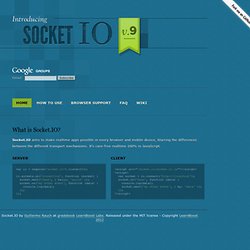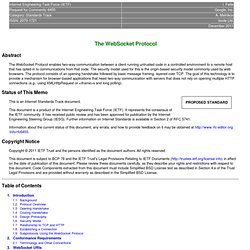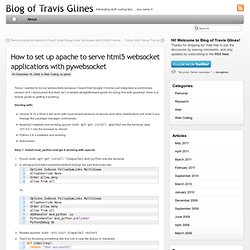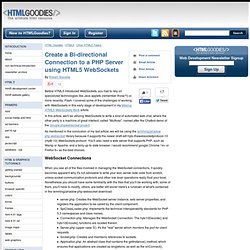

The cross-browser WebSocket for realtime apps. What is Socket.IO?

Socket.IO aims to make realtime apps possible in every browser and mobile device, blurring the differences between the different transport mechanisms.
Start Using HTML5 WebSockets Today. One of the coolest new features of HTML5 is WebSockets, which let us talk to the server without using AJAX requests.

In this tutorial, we'll review the process of running a WebSocket server in PHP, and then building a client to send and receive messages to it over the WebSocket protocol. What are WebSockets? WebSockets is a technique for two-way communication over one (TCP) socket, a type of PUSH technology. At the moment, it's still being standardized by the W3C; however, the latest versions of Chrome and Safari have support for WebSockets. The WebSocket Protocol. The WebSocket Protocol enables two-way communication between a client running untrusted code in a controlled environment to a remote host that has opted-in to communications from that code.

The security model used for this is the origin-based security model commonly used by web browsers. The protocol consists of an opening handshake followed by basic message framing, layered over TCP. The goal of this technology is to provide a mechanism for browser-based applications that need two-way communication with servers that does not rely on opening multiple HTTP connections (e.g., using XMLHttpRequest or <iframe>s and long polling). How HTML5 Web Sockets Interact With Proxy Servers. With the recent explosion of WebSocket server implementations, a lot of questions have come up about how HTML5 Web Sockets deal with proxy servers, firewalls, and load-balancing routers.

Will proxy servers automatically kill WebSocket connections? Do HTML5 Web Sockets handle firewalls and proxy server issues better than Comet? Are Web Sockets the silver bullet in seamless proxy server traversal? In this article, I’ll explain how HTML5 Web Sockets interact with proxy servers, load balancing routers, and firewalls. Mcolyer/em-websocket-proxy. Iuridiniz/stupid-websocket-tcp-proxy. Comparison of WebSocket implementations. Using apache-websocket to proxy tcp connections. At Flexiant, we had a need for a general websocket to tcp proxy.

A cute apache module to do extensible web-sockets programming has been developed by self.disconnect, and is available on github here. I’ve hacked around with this to produce a generic, apache licensed, websocket proxy. A websocket connection is made over HTTP or HTTPS to apache, this calls the websocket module, which in turn calls my module, which makes an outbound tcp connection. Some features: It supports base64 and text format sockets. The configuration section looks like this, in this case set up to proxy VNC using a novnc client: Pywebsocket - WebSocket server and extension for Apache HTTP Server for testing. How to set up apache to serve html5 websocket applications with pywebsocket. Today I wanted to try out websockets because I heard that Google Chrome just integrated a preliminary version of it.

I discovered that their isn’t a simple straightforward guide for doing this with apache2. Here is a simple guide to getting it working: Starting with: Ubuntu 9.10 (I think it will work with most recent versions of ubuntu and other distributions will work if you change the package manager commands)Apache2 installed and working (punch sudo apt-get install apache2 into the terminal, type 127.0.0.1 into the browser to check)Python 2.6.x installed and workingSubversion Step 1: Install mod_python and get it working with apache. Create a Bi-directional Connection to a PHP Server using HTML5 WebSockets. Before HTML5 introduced WebSockets, you had to rely on specialized technologies like Java applets (remember those?!)

Or, more recently, Flash. I covered some of the challenges of working with WebSockets in this early stage of development in my Making HTML5 WebSockets Work article. In this article, we'll be utilizing WebSockets to write a kind of automated web chat, where the other party is a machine of great intellect, called "Multivac", named after the Chatbot demo of the Google phpwebsocket project. Kanaka/websockify. Lemmingzshadow/php-websocket. Nicokaiser/php-websocket. Disconnect/apache-websocket. Real-Time Web Technologies Guide. Note: This page is a work in progress.

I plan to update it new technologies as I find them and increase the information on each as I find the time. If you know of a technology that should be included in this guide then please raise a pull request. If you have any questions please drop me an email me As above, you can contribute to the list by making a pull request to the Realtime Web Technologies Guide github repo. Hosted Realtime Services General Messaging & PubSub Ably Ably is a platform that makes it easy for you add realtime messaging and streaming data to your application. HTML 5 C# Web Sockets server and ASP.NET client implementation. In the previous post we saw that Web Sockets are the best invention since sliced bread: they bring to the web the bidirectional full-duplex communication traditional desktop applications have been enjoying for quite some time now.

It solves many current problems, and enables much more powerful applications than current standards. I’ve developed a very basic Web Socket server implementation in C# just as a proof of concept. It handles the most basic operations you would expect from a server: start a new connection, disconnect, and send and receive data. Besides, I’ve developed the client part as well using regular ASP.NET. Actually it’s just plain HTML and JavaScript being served from an ASP.NET server – this example doesn’t use any fancy runat=server controls or anything of the like. So what does this example do? Here’s a description of the public members of the Web Socket Server: 02.enum ServerStatusLevel { Off, WaitingConnection, ConnectionEstablished }; Tornado Web Server. Tornado is a Python web framework and asynchronous networking library, originally developed at FriendFeed.

By using non-blocking network I/O, Tornado can scale to tens of thousands of open connections, making it ideal for long polling, WebSockets, and other applications that require a long-lived connection to each user. Upgrade notes As of Tornado 3.2, the backports.ssl_match_hostname package must be installed when running Tornado on Python 2. This will be installed automatically when using pip or easy_install. Socketstream/socketstream. WebSockets: The Web Communication Revolution. Phpwebsocket - PHP and WebSockets. xRTML.org: The language for the real time web. WebSockets in PhoneGap Projects. I’m a big fan of the WebSockets API for all the real-time goodness it offers, but the iOS platform doesn’t (currently) bake the WebSockets API in to mobile Safari. That sucks, particularly because I can enjoy making iOS native apps using awesome frameworks like PhoneGap.
However, because I’m using PhoneGap, I can create a PhoneGap plugin that introduces WebSockets to my HTML & JavaScript. So that’s what I did. Installation I’m assuming you’ve got your PhoneGap project and XCode to manage and build the project. Step 1: Cocoa Async Socket Download and include AsyncSocket.h/.m from the cocoaasyncsocket project in your project directory (or some subdirectory, as you please). Next, drag these files (AsyncSocket.h/.m) in to the XCode project space – this will include the files properly when the project is built. WebSocket support in Android’s Phonegap apps « animesh kumar. We are developing a small game which can be played from multiple users using variety of clients, web-browser, Android, iPhone, iPad etc.
It’s like, there is a server and all clients connect to this server, and send and receive messages. We decided to use WebSocket for underlying connection between clients and server, and Phonegap to build clients. Our idea is to write the client once and then run it on variety of platforms. Websocket-android-phonegap/src/com/strumsoft/websocket/phonegap at master · anismiles/websocket-android-phonegap.
Push Real-Time Data over the Web.